Picture this: it’s the end of a long day and you sink into the couch, sighing into the long-awaited silence. Finally, some peace and quiet! And that’s when you hear it. It’s unmistakable – the scratch, scratch, scratch of a mouse skittering around your ceiling. You jump up from the couch, infuriated, when you see movement out of the corner of your eye. Was that another mouse in your kitchen? You stomp over, but the tiny rodent is long gone, likely stowed away safely under your refrigerator. But they didn’t escape without leaving you a small gift… mouse droppings. Confused and bewildered, you wonder to yourself: why do I have mice inside my home?
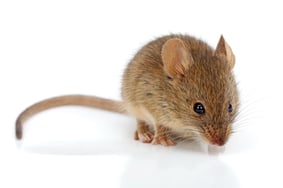
Everything you did (& didn’t) want to know about mice
To better understand why mice are appearing in your home, it’s essential to understand mice themselves.
Mice are small rodent mammals of the Muroidea superfamily. Sometimes confused with rats, mice are characteristically smaller in size than a rat and are easily recognized by their pointed snout, rounded ears, and long tails. Some of the more commonly encountered mice include the aptly named house mouse, deer mouse, and white-footed mouse. All three of these mice are known for their tendency to frequent homes and personal residences. Unfortunately for homeowners, these mice, like all mice, reproduce at incredibly prolific rates. The rapid reproduction of mice should be cause for concern when you find one in your home – chances are, if there truly is just one mouse in your house, there will be many more before long.
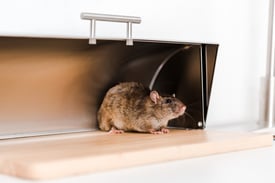
How long is a mouse’s life cycle?
Not only do mice reproduce expeditiously, but they can also live for a considerable amount of time if living safely indoors. Once a female mouse becomes pregnant, she will give birth in just three short weeks. Each litter can contain up to eight “pups,” and females may reproduce as many as ten times per year. The baby mice will reach maturity and be able to reproduce themselves within two months after being born. This cycle of reproduction will continue for the entirety of a mouse’s lifespan, which is approximately 2-3 years on average. Needless to say, this spells trouble for homeowners with a mouse problem.
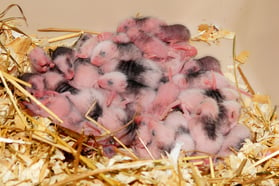
Why do I have mice in my home?
Mice are particularly drawn to certain areas within a home, such as garages, ceilings, inside walls, under kitchen cabinets or fridges, and in basements or crawl spaces. These mouse “hot spots” can help determine why mice have decided to take up residence in your home. What attracts mice to heavily trafficked and clearly occupied homes? Why do they choose to stay, live, and even reproduce in homes? And why can’t you get rid of them?
While there are seemingly limitless reasons why a mouse may enter your home or garage, there are a few broadly defined causes for unwelcome rodent visitors.
- Food - Whether you realize it or not, you could be unintentionally feeding the mice that make their way into your home. This is one major reason mice tend to seek out residences: unlimited food supply. Mice are hardy little creatures and can easily survive off of unnoticed crumbs and food scraps, or worse, make their way into your kitchen pantry for the real buffet. Mice are also known to help themselves to bags of grain, birdseed, grass seed, pet food, or other bulk food items that you may store in your garage. They may squeeze their way into your car in search of trash like half-empty takeout bags or dropped morsels from your morning's grab-and-go breakfast.
- Water - Your home can be a reliable water source for mice. With so many rooms having access to readily available water – think kitchens, bathrooms, laundry rooms, and even garages – mice will never have to stray from the home for a quick drink. Mice are capable of going a month or more without water, and even with easily accessible water available to them, they only need about 4ml to be quenched. Because they need so little water, they can survive by finding it in unexpected ways, such as by drinking condensation from water pipes, consuming excess water from houseplants, and helping themselves to a pet’s water bowl. This means that no matter how watertight you believe your home is, a mouse can still thrive.
- Shelter - The most obvious reason that mice scurry indoors is for shelter from predators and the elements. In the summertime, mice will seek shelter for a reprieve from the heat. As we cool our homes for our own comfort throughout the summer, we’re unintentionally providing a temperature-controlled environment perfect for mice to find relief in. The same can be said for the winter. Consistently warmed homes offer an escape for mice from the bitter cold and provide an excellent home base for building their nests. The constant need for comfortable and safe shelter is exactly why mice are not considered a seasonal pest but rather a year-round one. This is especially true for homes with garages, where mice can live undetected for a long time and find plenty of dark places to hide and nest.
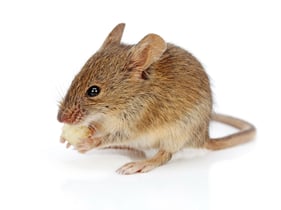
How are mice getting inside my home?
Now we understand a little better why mice have entered your home in the first place, but still, the question remains: how are they getting in? Because mice are so small, they can gain entry through even the most unlikely of spots. Some common entry points for mice include gaps or cracks in your foundation, holes in a home’s exterior, gaps under garage doors, outside vents, or through attics and basements. You may believe that there are no holes large enough for mice to enter your home through, but this is likely, not true. A mouse’s body is remarkably pliable and capable of squeezing in ways a human can't. Mice have flexible bodies that can slip through cracks as small as a quarter of an inch wide – that’s about the width of a pencil!
What kind of damage can mice cause in my home?
Though small, mice can cause significant damage to your home. Perhaps most concerning of all is the structural damage mice can inflict on homes through their incessant chewing, nest-building, and defecation. Some other troublesome repercussions of a mouse infestation include:
- Burrowing into upholstered furniture and building nests inside.
- Tunneling through insulation and using the material to build softer nests.
- Gnawing the rubber insulation of wires behind walls, resulting in the potential for electrical fires.
- Chewing through and destroying expensive or sentimental items, including artwork, documents, heirlooms, books, and more.
- Their urine and droppings can stain and ruin ceilings, walls, and more. These trails also attract more mice, the scent of their defecation serving as a beacon to other rodents, saying: this is a good place to live!
The damage mice can leave in their wake isn’t limited to strictly material items, either. Mice are capable of carrying and spreading diseases that are harmful to humans. Some diseases mice are known to spread include hantavirus, salmonella, and lymphocytic choriomeningitis. These diseases are commonly spread through a mouse’s droppings. Even if you are careful to handle the droppings with gloved hands, you may still be at risk. Mice urine and droppings can dry and eventually turn to dust, then becoming airborne and leaving homeowners susceptible to breathing in harmful viruses.
It should be noted that some diseases carried by mice can also be transmitted to your pets. Humans can be vulnerable to passed viruses from cats and dogs, as well.
What do mouse nests look like?
Mouse nests are easy to spot so long as you know where to look. Mice prefer to build nests in places that are relatively warm, dark, and narrow. Garages, ceilings, and crawl spaces are all places you should check if you suspect a mouse infestation. Mouse nests themselves are identifiable by their ball-like appearance with a single entrance and exit point. Mice use a variety of materials to build their nests, much of which they've likely taken from within your residence. Anything soft or pliable is perfect material for mice constructing their nests. Materials include paper, fiberglass insulation, string, mattress batting, tissues, and even foliage from houseplants are some common mouse favorites.
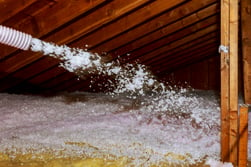
What are the signs of a mouse infestation?
Before stumbling on a mouse's nest, you're likely to have witnessed some signs of an infestation. Mice tend to be pretty conspicuous intruders despite their small size. Here are some telltale signs that you've got a mouse infestation in your home:
- Droppings: mouse excrement looks like small, dark pellets and is often plentiful. Mice can leave anywhere from 50-80 droppings in a single night.
- Grease marks: mice and other rodents can leave dark smears along frequently travelled routes in your home as their body brushes up against the walls or baseboards routinely.
- Urine pillars: in well-established or severe infestations, a collection of grease, dirt, and urine can create small mounds up to 4cm high.
- Scratching sounds: mice are most active during the night which is conveniently when our own activity tends to die down. During a mouse infestation, you'll likely be able to hear scratching and skittering in your ceiling, walls, floorboards, attic, or garage at nighttime.
- Strong smell: mice urine is incredibly pungent and ammonia-like in scent. You may be able to smell this if you are near a nest or in an area of high activity. The scent can also linger well after an infestation has been rectified.
How can I get rid of mice inside my home?
There are a multitude of products on the market that claim to get rid of mice quickly. These products can have varying degrees of effectiveness and rarely offer a long-term solution to mouse problems. Some of these solutions include:
- Repellants
- Bait traps
- Live traps
- Ultrasonic deterrent devices
- Spray application methods
In general, we advise against DIY methods of mice removal for a variety of reasons. DIY methods can often be ineffective or only temporarily effective, potentially dangerous (especially to children and pets!), and often expensive in the event that removal requires several attempts.
For reliable mice removal, we recommend contacting a reputable pest control company such as EcoShield at the first sign of a mouse in your home. EcoShield’s proven and guaranteed 3-step process addresses mice infestations holistically and provides protection for not only the current problem but future problems, as well.
EcoShield's exclusion services are an effective solution to eliminate mouse and rodent infestations, by removing and treating existing infestations and by also sealing and repairing entry points to prevent mice from continuing to enter your home.
If you are experiencing problems with mice in your home, give EcoShield a call today or fill out the form at the bottom of this page. Our experts are ready to help remove mice and ensure your home stays pest-free for the ultimate health and safety of you and your loved ones.